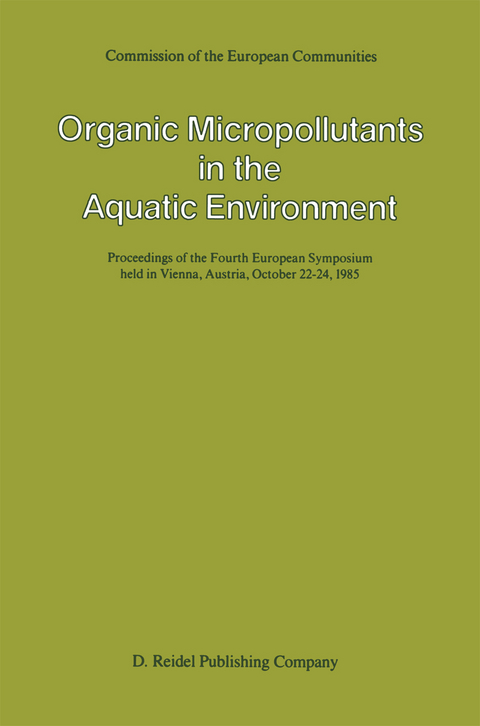
Organic Micropollutants in the Aquatic Environment
Kluwer Academic Publishers (Verlag)
978-90-277-2242-3 (ISBN)
- Titel z.Zt. nicht lieferbar
- Versandkostenfrei innerhalb Deutschlands
- Auch auf Rechnung
- Verfügbarkeit in der Filiale vor Ort prüfen
- Artikel merken
Analytical Methodologies.- Low dispersion liquid chromatography : Application of fast and narrow bore liquid chromatography to the analysis of micropollutants.- Identification of surfactants and study of their degradation in surface water by mass spectrometry.- Recent LC/MS methods for water analysis.- The status of the development of standard procedures for the analysis of organic priority pollutants in water samples in the Federal Republic of Germany.- Determination of organometallic compounds in the aquatic environment.- HPLC determination of priority list aromatic hydrocarbons.- FAB — Mass spectrometric study of the non volatile organic fraction in raw and drinking water extracts.- Pollution conditions of the aquifer beneath a plant producing alkyd resins.- Analyse de micropolluants organiques des eaux par couplage CG/SM — Collection de spectres de masse de référence.- Improvement in estimation of polyaromatic hydrocarbons in seawater, marine sediments and organisms by spectrofluorometry by using standard additions method.- A comparison of procedures for trace enrichment of organophosphorus pesticide residues from water.- The Kovats indices of some organic micropollutants on an SE54 capillary column.- A dual detector gas chromatographic system for the routine determination of retention indices.- Methods for the determination of EEC priority pollutants.- Evaluation of sample preparation procedures for the determination of organic micropollutants in river sediments.- Tracing a source of pollution by determination of specific pollutants in surface- and groundwater.- Determination of extractable organohalogens in living tissue.- Determination of acidic and neutral residues of alkylphenol polyethoxylate surfactants using GC/MS analysis of their TMS derivatives.-Determination of PCB-congeners in sediment samples using a retention index system.- Transport of Organic Micropollutants in the Aquatic Environment.- Sorption behaviour of neutral and ionizable hydrophobic organic compounds.- Properties of humic material in relation to transport phenomena.- PCB congeners in the marine environment — A review.- Dispersion et évolution des hydrocarbures pétroliers dans l’environnement marin. Cas de référence: la pollution de l’Amoco Cadiz.- Bioaccumulation of chlorinated paraffins — A review.- Investigation of the influence of aquatic humus on the bioavailability of chlorinated micropollutants towards fish.- Mixtures of hydrophobic chemicals in aqueous environments: Aqueous solubility and bioconcentration by fish of Aroclor 1254.- Comparative analysis at the molecular level of the interactions between organic and inorganic mercury compounds and membrane lipidic bilayers.- Experimental systemic study of the accumulation and transfer processes of organic and inorganic mercury in freshwater environment — Methodology and results.- Bioaccumulation by fish in relationship to the oxygen concentration in water.- Transformation in the Aquatic Environment.- Biodegradation of chlorinated compounds.- Review of microbial transformations.- Biotransformation of nitroaromatic compounds.- Aquatic photochemistry : future developments.- New reactions involved in non-aerobic degradation of aromatic compounds.- Total biodegradation of chlorinated biphenyls by a pseudomonas strain.- Possibilities of predicting the production of lipophilic volatile organohalides chlorination of sea water and fresh water samples in laboratory conditions.- Orchard spraying with organophosphorus pesticides : Occurrence and fate of parent compounds and phosphoruscontaining hydrolytic products in adjacent ponds.- Microbial degradation of nitrilotriacetate (NTA) in groundwater: Laboratory studies under aerobic and anaerobic conditions.- Characterization and biodegradability of lignin containing wastewater from forest industry.- Water Treatment Processes.- Formation and removal of organic micropollutants in drinking water treatment.- Chemical and biological characterization of industrial effluents and applied mathematical modelling — A case study.- Risk estimation as a method for modelling the fate and impact of industrial effluents in marine environments.- Das NTA-Problem.- Behaviour of nonionic surfactants in biological waste water treatment.- A data base on behaviour and effects of organic pollutants in waste water treatment processes.- PAH in water systems, effect of aquatic humus and chlorination.- Properties of mutagenic compounds formed during chlorination of humic water.- Behaviour of organic micropollutants during infiltration of river water into ground water : Results of a field study in the Glatt Valley, Switzerland.- Theoretical Aspects and Future Activities.- Mathematical modelling of the behaviour of organic micropollutants in the aquatic environment.- Quantitative structure-activity relationships in aquatic toxicology.- Indices for the prediction of environmental properties of hetero-atomic polycyclic aromatic pollutants.- Integration and use of the list of organic micropollutants in the aquatic environment in the ECDIN data bank.- Environmental research of the European Communities in the future.- List of Participants.- Index of Authors.
| Zusatzinfo | 528 p. |
|---|---|
| Verlagsort | Dordrecht |
| Sprache | englisch |
| Themenwelt | Sachbuch/Ratgeber ► Natur / Technik ► Natur / Ökologie |
| Naturwissenschaften ► Biologie ► Ökologie / Naturschutz | |
| Technik ► Elektrotechnik / Energietechnik | |
| Technik ► Umwelttechnik / Biotechnologie | |
| ISBN-10 | 90-277-2242-0 / 9027722420 |
| ISBN-13 | 978-90-277-2242-3 / 9789027722423 |
| Zustand | Neuware |
| Haben Sie eine Frage zum Produkt? |
aus dem Bereich


